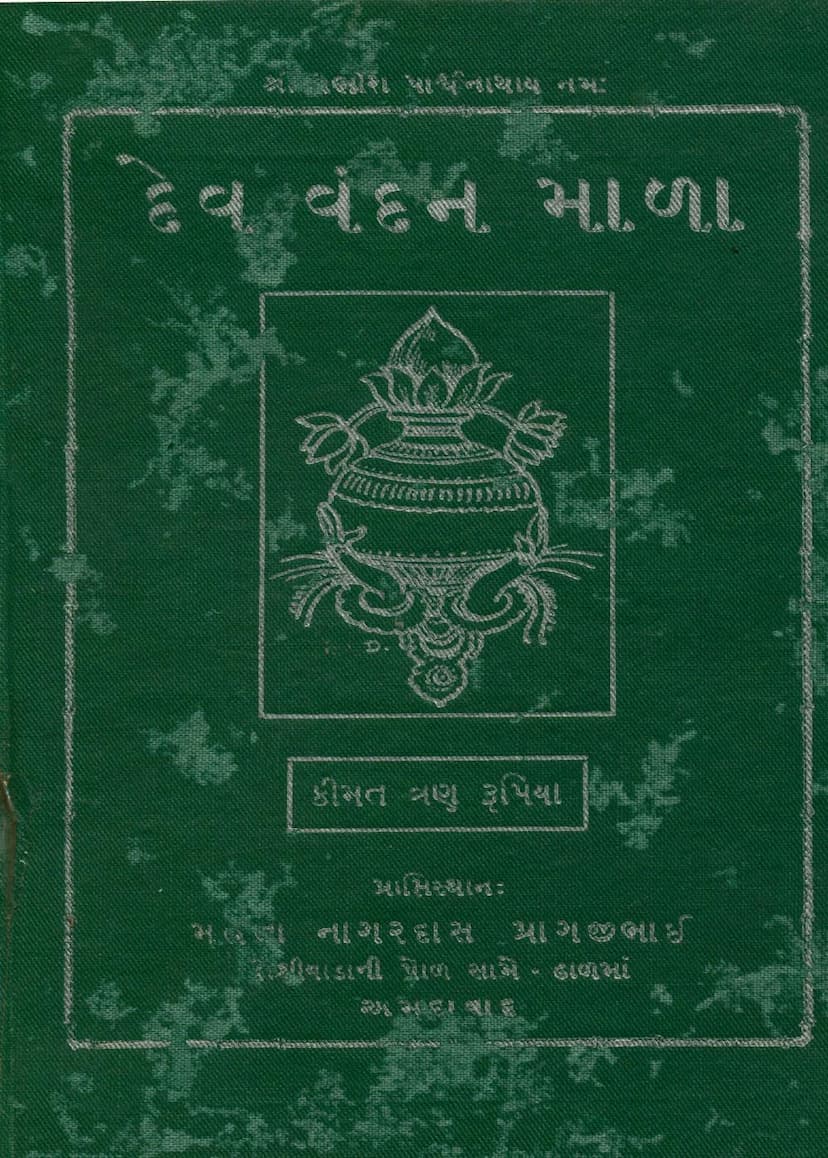Devvandanmala
Added to library: September 1, 2025

Summary
This comprehensive summary is based on the provided Jain text, "Devvandanmala," authored by Sanghvi Muljibhai Zaverchand. The book is a collection of various devotional songs and prayers (Devvandan) composed by different Jain scholars and monks, intended for recitation and worship.
Here's a breakdown of the content and key aspects:
Book Title: Devvandanmala (Collection of Devotional Offerings/Worship) Author/Publisher: Sanghvi Muljibhai Zaverchand (Likely the compiler/publisher, as the authors of individual pieces are mentioned separately). Catalog Link: https://jainqq.org/explore/032403/1
Overall Purpose: The Devvandanmala is a compilation of devotional hymns and prayers designed for various Jain festivals and occasions. It aims to provide devotees with the correct rituals and the spiritual context behind them, fostering deeper devotion and understanding of Jain principles.
Key Features and Content:
-
Structured Devotional Practice: The book is organized to guide devotees through a complete worship (Vandan) process. This includes:
- Introduction to Devotional Recitation: It clarifies the purpose and significance of each section.
- Biographies of Composers: For many of the Devavandanas, the book provides brief introductions to the authors, highlighting their spiritual lineage and contribution. This adds a layer of historical and devotional context.
- Narrative Context (Katha): Before presenting a specific Devavandana, the book often includes a story related to the festival or occasion, explaining its significance and the glory of the Tirthankaras or other revered figures. This helps in understanding the underlying emotions and intentions behind the prayers.
- Inclusion of Supporting Chants: Essential prayers and verses that often accompany the main Devavandana, such as "Satikar," "Tiyapangatt," "Namman," "Ajitshanti," "Madhi Shanti," "Bhaktamar," and "Chaityavandan Bhashya," are included.
-
Specific Devavandanas Covered: The book includes Devavandanas for various important Jain occasions throughout the year:
- Gyan Panchami (Festival of Knowledge): Composed by Shri Vijayalakshmisuri, this section details the nature of the five types of knowledge and the reasons for the binding of knowledge-obscuring karma. It includes the story of Vardatta and Gunamanjari, who attained salvation through the worship of knowledge.
- Chowmasi Devavandan (During the Four-Month Monastic Retreat):
- Composed by Pandit Shri Viravijayji: This part includes Chaityavandanas for all 24 Tirthankaras, with specific stanzas (stavan) for the first, sixth, twenty-second, twenty-third, and twenty-fourth Tirthankaras, and prayers for eternal and non-eternal Tirthankaras, as well as the five major Tirthas.
- Composed by Pandit Shri Padmavijayji: This section follows a similar structure.
- Maun Ekadashi (Silent Eleventh Day):
- Composed by Pandit Shri Rupvijayji: This section describes the 150 Kalyanaka (auspicious events) of the past, present, and future Tirthankaras and includes the ritual for Maun Ekadashi.
- Composed by Shri Gyanavimlasuri: Another set of Devavandanas for this occasion.
- Chaitri Punam (Full Moon Day of Chaitra):
- Composed by Shri Danvijayji: This highlights the importance of Shri Shatrunjay Tirth, the arrival of Shri Rishabhdev Bhagavan, and the attainment of liberation by Shri Pundrik Swami on Chaitri Punam.
- Composed by Shri Gyanavimlasuri: Another set of Devavandanas for this occasion.
- Diwali Devavandan: Composed by Shri Gyanavimlasuri, detailing the Moksha (liberation) of Shri Mahavir Swami and the attainment of Kevaljnana by Gautam Swami on this day.
- Eleven Gana Dharas Devavandan: Composed by Shri Gyanavimlasuri, detailing facts related to the eleven chief disciples (Gana Dharas) of Shri Mahavir Swami.
-
Emphasis on "Kadibaddha" (Verse-by-Verse) Structure: A notable feature of this Devavandanmala, as mentioned in the preface, is its verse-by-verse (kadibaddha) format, making it easier for devotees to read and follow during worship compared to previous compilations that might have been in a more continuous prose style.
-
Elaboration on Rituals and Significance: The book explains the purpose of various elements used in worship, such as placing books on a raised platform, offering incense and flowers, lighting lamps, drawing auspicious symbols (sathiya), and performing specific vows and austerities.
-
Inclusion of Stories and Legends: The inclusion of narratives like Vardatta and Gunamanjari (Gyan Panchami), Kumar Pal's story during Chowmasi, and Sur Sheth's devotion for Maun Ekadashi, adds depth and makes the devotional practice more relatable and inspiring.
-
Specific Details for Each Devavandana: The preface and subsequent sections provide details about:
- The composer of each Devavandana.
- The specific occasion it pertains to (Gyan Panchami, Chowmasi, Maun Ekadashi, Chaitri Punam, Diwali).
- The core themes and stories associated with each occasion.
- The specific dates on which these are typically observed (e.g., Kartik Sud 5th for Gyan Panchami, Kartik Sud 14th, Phagan Sud 14th, Ashad Sud 14th for Chowmasi).
-
Acknowledgement and Gratitude: The concluding remarks often include thanks to individuals who helped in the preparation and editing of the book, as well as a plea for forgiveness for any errors (Michchhami Dukadd).
Target Audience: This book is intended for Jain monks, nuns, scholars, and lay devotees (Shravaks and Shravikas) who wish to perform their daily or festival-specific worship (Devavandan) with proper understanding and devotion.
Overall Impression: The "Devvandanmala" by Sanghvi Muljibhai Zaverchand is a valuable resource for the Jain community. It meticulously compiles essential devotional texts, making them accessible and understandable through the inclusion of narratives and biographical sketches. The emphasis on the "kadibaddha" format and the inclusion of accompanying chants and rituals indicate a well-thought-out approach to promoting authentic and heartfelt Jain worship.